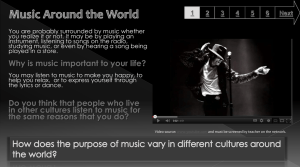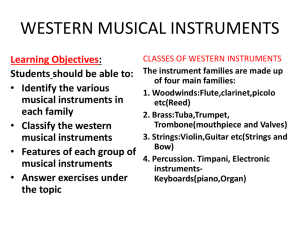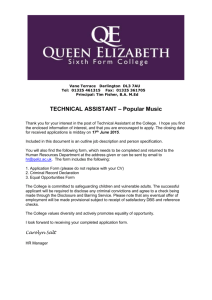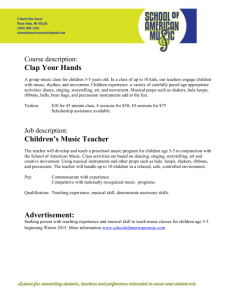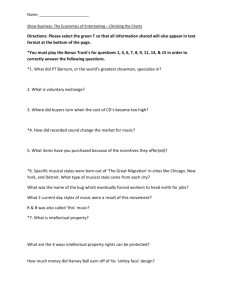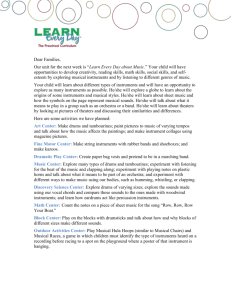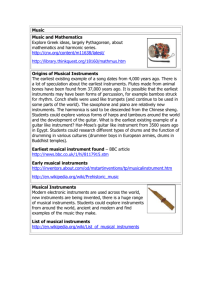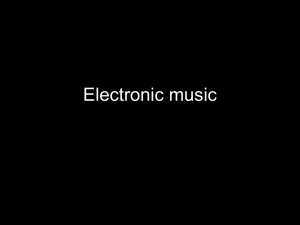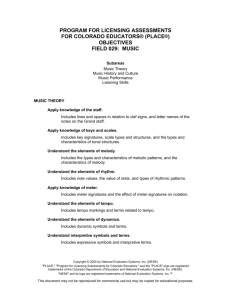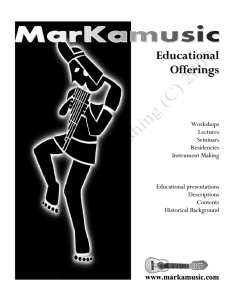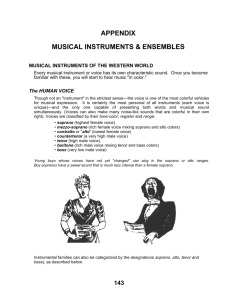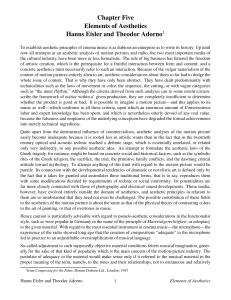Music Appreciation - Amazon Web Services
advertisement
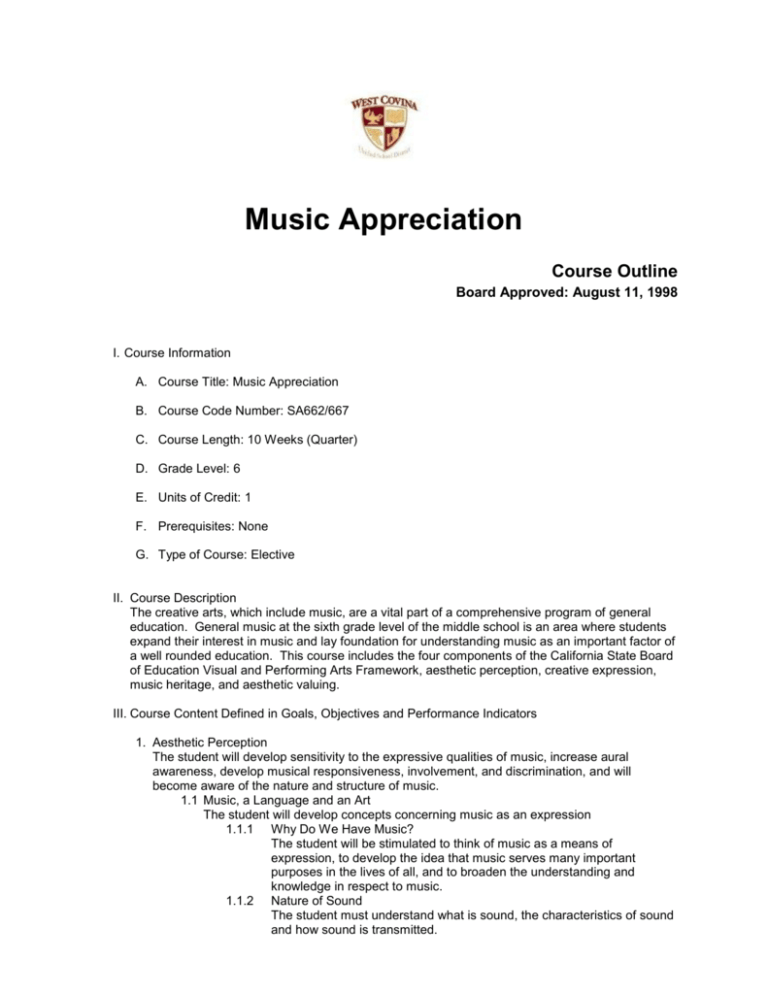
Music Appreciation Course Outline Board Approved: August 11, 1998 I. Course Information A. Course Title: Music Appreciation B. Course Code Number: SA662/667 C. Course Length: 10 Weeks (Quarter) D. Grade Level: 6 E. Units of Credit: 1 F. Prerequisites: None G. Type of Course: Elective II. Course Description The creative arts, which include music, are a vital part of a comprehensive program of general education. General music at the sixth grade level of the middle school is an area where students expand their interest in music and lay foundation for understanding music as an important factor of a well rounded education. This course includes the four components of the California State Board of Education Visual and Performing Arts Framework, aesthetic perception, creative expression, music heritage, and aesthetic valuing. III. Course Content Defined in Goals, Objectives and Performance Indicators 1. Aesthetic Perception The student will develop sensitivity to the expressive qualities of music, increase aural awareness, develop musical responsiveness, involvement, and discrimination, and will become aware of the nature and structure of music. 1.1 Music, a Language and an Art The student will develop concepts concerning music as an expression 1.1.1 Why Do We Have Music? The student will be stimulated to think of music as a means of expression, to develop the idea that music serves many important purposes in the lives of all, and to broaden the understanding and knowledge in respect to music. 1.1.2 Nature of Sound The student must understand what is sound, the characteristics of sound and how sound is transmitted. 1.1.3 1.1.4 Sound Production The student will define sound from various sources, including the different types of instruments. Elements of Music The student must understand the relationship among these elements, pitch, rhythm, harmony, form, texture, tempo, dynamics, and timbre. 2. Creative Expression Involvement in musical expression requires that the participants develop technical skills. 2.1 Auditory Skills The student will demonstrate the development of listening skills. 2.1.1 Musical Instruments The student will gain knowledge in becoming acquainted with the tonal qualities of the various instruments of the band and orchestra. 2.1.2 Style Recognition The student will listen for and identify the style of various selections of music literature. 2.1.3 Elements and Function The student will listen for and identify the use of the elements in music through recordings. 2.2 Translative Skills or Skills of Reading and Music Writing The student will have an understanding of basic music theory, vocabulary, and meter. 2.3 Performance Skills The student will participate in singing, playing of instruments, body movement, and conducting. 2.3.1 Singing The student will have the knowledge that the human voice is an instrument, and will have the opportunity to use his/her voice in song. 2.3.2 Instruments The student will be given the opportunity to explore and participate in playing on simple wind and percussion instruments. 2.3.3 Body Movement The student will have the chance to participate in exploring the elements of music through movement. 2.3.4 Conducting The student will experience music by knowing what a conductor does when standing in front of musicians. 3. Music Heritage The student will develop an awareness and understanding of the styles, idioms, performance media, and purposes of music that are part of our multicultural heritage. 3.1 Music History The student will discuss the history of music, its social and physical influences and its evolution to music as it is heard today. 3.1.1 Periods of Music History The student will discuss music from the early Baroque to contemporary music and analyze the musical elements in each type of music literature. 3.1.2 Social and Physical Influences The student will discuss the social factors that influenced music, as well as site the environmental and technological capabilities through time. 3.1.3 Evolution The student will discuss the evolution of music as it relates to the elements of music. 3.2 Music of the World The student will recognize and analyze music as it is heard throughout the world. 3.2.1 Regions and Music The student will recognize various types of music that characterize different regions around the world. 3.2.2 Analysis The student will analyze each region’s music for its elements of music and the social/physical influences. 3.3 Styles of Music The student will have an understanding of the various styles of music. 3.3.1 Style Recognition The student will recognize the different periods of music literature through the use of music elements. 3.4 Purpose of Music The student will recognize and discuss the importance of all forms of music as they are found in cultures throughout the world. 3.4.1 Music as a Part of Living The student will cite examples of how music affects his/her everyday life. 3.4.2 Effects on Human Behavior The student will recognize and cite examples of how music is used to elicit emotion. 3.4.3 Entertainment The student will recognize music as a universal language used throughout the world and experience its entertainment value. 4. Aesthetic Valuing The student will receive a sound basis of musical experiences which the student can use in making intelligent judgments of music value. 4.1 Background of Music The student will discuss the importance of music in time and place and explore its effectiveness. 4.1.1 Music in Time The student will become aware of how music fits the time of its development and what displacement in the time might accomplish. 4.1.2 Music in Place The student will discuss how music fits into each culture and what displacement into other cultures might accomplish. 4.2 Function of Music The student will rationalize and defend appropriate choices of music according to function. 4.2.1 Appropriate Function The student will discuss the validity of music as it is used in various situations. A comparison of styles and elements will be used. 4.2.2 Inappropriate Function The student will discuss music that may be out of place and describe why it may not belong. A comparison of style and elements will be used. 4.3 Judgment of Music The student will demonstrate an appreciation for music as an expressive art form. 4.3.1 Personal Preferences The student will rationalize and defend the style, elements and cultural background of the music preferred and discuss its effectiveness. 4.3.2 Other Preferences The student will rationalize and defend the style, elements and cultural background of other forms of music, regardless of personal preference and discuss its effectiveness.



